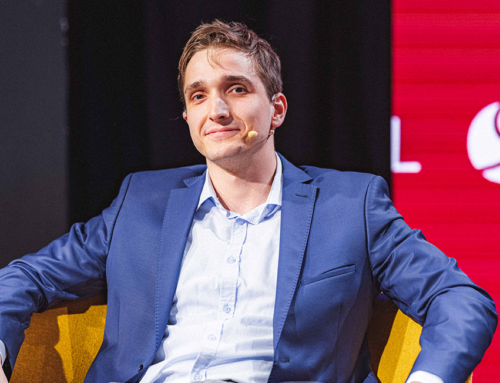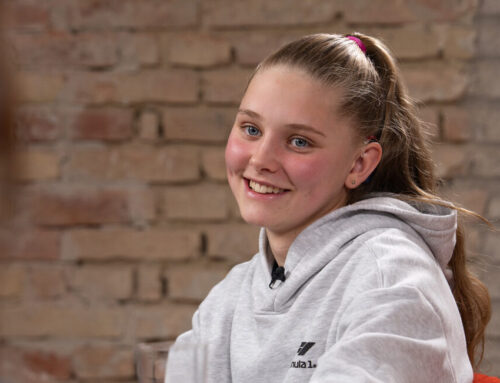The experience of a cochlear implant user
“Everybody is trying to tell you that you have one hearing ear left, so what? But it’s so difficult.” Today, Sabine Weinberger-Pramendorfer is extremely satisfied with her cochlear implant and wants to encourage candidates to go for it.

“I literally lost my hearing over night.” Sabine Weinberger-Pramendorfer, a trained confectioner, worked for a big restaurant chain. Her job involved irregular working hours and extensive business trips all over Austria. One early morning, on one of her business trips, her mobile phone rang repeatedly. Every time Sabine answered it though, the caller remained silent. “Strange”, she thought, “first they call and then they refuse to talk.” When she switched the phone over to the right ear she suddenly realized that she seemed to have lost the hearing in her left ear. This was back in spring 2018.
Whether the sudden hearing loss was due to her stressful life or a cold was impossible to tell. In mild cases, a sudden hearing loss can recover spontaneously within hours or days. But Sabine’s hearing loss was not only profound, but unfortunately also very stable. Neither treating her cold nor a specific infusion therapy brought any improvement.
Eventually, Sabine had to acknowledge the fact that her single-sided deafness would remain. “I tried to convince myself that it wouldn’t make a big difference”, she recalls. “But when I left the hospital, I had to be particularly careful not be be run over by car. I heard everything coming from the right when in fact the car was coming from the left.”
“It was so exhausting!”
“Sitting in the cafeteria and chatting, like we are doing now, would not have been possible back then.” Sabine Weinberger-Pramendorfer is sitting opposite me in the cafeteria of an Upper Austrian hospital. It’s busy behind us: About twenty guests scattered along several tables are chatting along or noisily turning the pages of their newspapers. The waiter is taking orders, serving coffee and cakes and taking cash. A name is being called out from a loudspeaker. Having a conversation in a room full of background noise would have required enormous efforts with only one ear. “I would have had to ask you to sit on my right side, my hearing ear.”
Her job in an open-plan office required double efforts. Driving her car through Austria also felt extremely strenuous. “Everything took much longer”, Sabine describes her compromised performance, comparing it to chronic sleep deprivation. “I was so tired, I always felt like lying down for a mid-day nap.” She also got more sensitive to noise. “I gave up my job in the end, because it became too stressful”, Sabine sighs.
Directional hearing equals safety
She also faced significant changes in her private life. The passionate mountain biker had to give up her hobby because she lacked directional hearing: “I heard another biker coming from behind and most certainly went to the wrong side to let them pass. It simply was too dangerous for me.”
Private invitations became tedious as well. “I did not want to tell everybody that I was deaf on my left ear.” If Sabine wanted to understand the people sitting on her left, she had to turn her right ear towards them, which often entailed unusual contortions of her upper body. Whenever possible her husband sat on the side of her deaf ear to prevent Sabine from embarassing situations. But he was not always around.
An early Christmas present
Sabine did not want to accept her single-sided deafness and all the limitations that came with it. She first saw a hearing aid dispenser. But with the hearing loss in her left ear being so severe a hearing aid did not bring any benefits. The chief physician at the Upper Austrian ENT clinic recommended a cochlear implant. Her name was put on the waiting list. “Of course I also considered alternatives. But it was clear to me that I could not do without hearing with both ears. It would have meant too many limitiations for my life. And I wanted to do something in case my good ear would deteriorate one day.”
In addition to the hearing loss, a cholesteatoma, a tumor in the middle ear, had to be removed before cochlear implantation. Ultimately, it took 18 months before Sabine received her CI. Quite a long time which, however, did not help her to get used to hearing with only one ear. Her implantation on December 22 was an early Christmas present for Sabine.
A part of me
“I was looking forward to the exciting moment when the audio processor would be switched on for the first time. Would it work? Joyful anticipation outweighed anxiety: “I was convinced that things would change for the better.” Now an experienced CI user, she advises candidates against high expectations in the beginning, although it did not take long for her first hearing success and progress with the CI. “It’s coming slowly.”
“In quiet situation, when you don’t expect any sound sensation, the new impressions with the CI may initially be irritating”, Sabine states. “I forced myself to wear the processor all day.” She also did listening trainings with an induction loop and the ListenUp! apps. Today, she is able to effortlessly follow conversations in difficult listening environments: in large, reverberant conservatories, in shops with background music or in busy restaurants.
Sabine is extremely satisfied with her CI system and wants to encourage other candidates to go for implantation. She is also looking forward to taking a fresh start in her professional life. And with a new helmet she is determined to ride her mountain bike again soon. Her audio processor is changing appearance thanks to different covers. The discreet design will soon make way for a poppier one. “Or maybe a rhinestone”, she reflects. She prefers her processor to be stylish rather than discreet: “Because it is now a part of me!”






